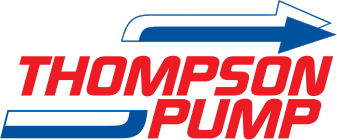Thompson Pump Aids in Clarifier Refurbishment
The West Side Treatment Plant in Kansas City, MO recently made plans to refurbish one of their clarifiers. A clarifier is a tank that holds and separates solids and sediment from the effluent. Pumps were required to remove the sewage from the clarifier to allow crews to come in and make modifications. After hearing about a similar successful application at the Blue River Treatment Plant, Kansas City, MO., Thompson Pump’s Kansas City Branch was contacted. Thompson’s representative was able to supply a 6-inch Compressor-Assisted Dry Prime Open Trash Sewage Pump with the ENVIRORPIME® Priming System. In addition to the pump, 100-feet of suction hose was supplied to ensure that suction could be attained from all parts of the clarifier.
At the Blue River Treatment Plant a competitor already had a pump installed and was pumping one of their clarifiers when the Kansas City Thompson Pump representative showed up to provide a demonstration of the 6-inch Compressor-Assisted Dry Prime Open Trash Sewage Pump with the ENVIRORPIME® Priming System. The pump employs the ENVIROPRIME® Priming System, which was specifically designed to completely eliminate blow-by (when effluent infiltrates and escapes through the priming system), making it perfect for sewage applications, and safe to the environment. The pump also includes a self-priming centrifugal pump end, which provides its own air handling capability, which is furthered by the additional air handling capability from the priming system, making it perfect for high head/ high volume applications such as this one. The representative suggested installing the Thompson pump on the clarifier next to the one the competition was pumping – for a true side-by-side comparison.
The competitive pump was experiencing less-than-desired results: The competitive pump that was used was an 8” Dry Priming Pump with an end-suction centrifugal pump end which is not capable of handling air on its own, relying entirely on its priming system’s air handling capability. The competitive pump seemed to be trying to maintain prime rather than operating at its full capacity. Also, accommodations were required to redirect any blow-by experienced by the competition’s pump. A hose was attached to the pump’s priming system that would redirect the effluent back into the clarifier. In addition, it was mentioned that the competitive pump would eventually have to be lowered into the clarifier in order to be able to pump the effluent efficiently as it reached the middle of the tank.
This high air handling ability allowed the Thompson pump to remove the air from the suction line to allow the pump to handle the high suction lift without having to lower the pump into the clarifier. While the Thompson Pump was a 6” pump, it still outperformed the competitor’s 8” pump, impressing the Blue River Treatment Plant crews who rented the pump for their application. They were so pleased with the pump that they went ahead and recommended Thompson Pump to the West Side Treatment Plant.
The applications at both the West Side Treatment Plant and the Blue River Treatment Plant were successful and the clarifiers were restored to optimal working condition.
